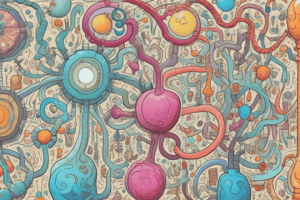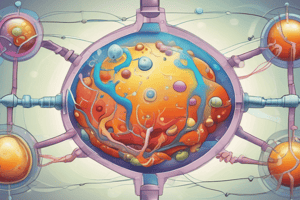Podcast
Questions and Answers
Which of the following compounds contains a longer carbon chain?
Which of the following compounds contains a longer carbon chain?
- Citric acid
- Acyl-CoA (correct)
- Acetyl-CoA
- Glucose
Which role is primarily associated with Acetyl-CoA?
Which role is primarily associated with Acetyl-CoA?
- Contains a four carbon chain
- Central in energy production (correct)
- Involved in cellular signaling
- Involved in fatty acid metabolism
What occurs during the process of dehydrogenation?
What occurs during the process of dehydrogenation?
- Attachment of a phosphate group
- Addition of water
- Formation of a triple bond
- Removal of hydrogen atoms (correct)
Which of the following is true about Acyl-CoA?
Which of the following is true about Acyl-CoA?
What happens during the hydration step of the process described?
What happens during the hydration step of the process described?
What happens during the dehydrogenation process mentioned?
What happens during the dehydrogenation process mentioned?
What does the acetyl-transfer process do to the fatty acid chain?
What does the acetyl-transfer process do to the fatty acid chain?
Where does fatty acid synthesis occur?
Where does fatty acid synthesis occur?
What is the first step in fatty acid synthesis?
What is the first step in fatty acid synthesis?
How is acetyl-CoA transported into the cytosol for fatty acid synthesis?
How is acetyl-CoA transported into the cytosol for fatty acid synthesis?
What molecule forms when fatty acids are attached to CoA?
What molecule forms when fatty acids are attached to CoA?
How are fatty acids transported into the mitochondria?
How are fatty acids transported into the mitochondria?
What happens once fatty acids are inside the mitochondria?
What happens once fatty acids are inside the mitochondria?
What is the main difference between acetyl-CoA and acyl-CoA?
What is the main difference between acetyl-CoA and acyl-CoA?
How are high energy molecules for ATP production generated during fat metabolism?
How are high energy molecules for ATP production generated during fat metabolism?
Flashcards are hidden until you start studying
Study Notes
Dehydrogenation
- Dehydrogenation converts -OH group on beta carbon into a C=O double bond, making the molecule more reactive.
- Involves removal of hydrogen atoms from a specific place in a molecule, transferring them to FAD+ and forming a double bond between neighboring carbon atoms.
Acetyl-CoA
- Central in energy production, entering the citric acid cycle to generate energy.
- Forms when fatty acid chain is broken down into smaller pieces, producing energy in citric acid cycle.
- Can be converted from citrate, which is formed in mitochondria, and then transported into cytosol for fatty acid synthesis.
Fatty Acid Synthesis
- Occurs in cytosol, converting acetyl-CoA into malonyl-CoA (a 3-carbon molecule) and then adding more acetyl groups to build a longer fatty acid chain.
- Involves the combination of acetyl-CoA and malonyl-CoA to form a longer fatty acid chain.
Fatty Acid Breakdown
- Fatty acids are attached to CoA, forming acetyl-CoA, which is then broken down into smaller pieces, each with 2 carbon atoms, to produce energy.
- Breaking down fatty acids generates acetyl-CoA, which enters the citric acid cycle to produce high-energy molecules used for ATP.
- Fatty acids are transported into mitochondria by attaching to carnitine, and then removed to form acetyl-CoA, which is broken down for energy.
Acyl-CoA vs Acetyl-CoA
- Acyl-CoA has a longer carbon chain and is involved in the metabolism of fatty acids.
- Acetyl-CoA contains two carbon acetyls and is central in energy production, entering the citric acid cycle to generate energy.
4 Steps in Fatty Acid Breakdown
Hydration
- Water is added to the double bond formed in dehydrogenation, changing the double bond to a single bond and attaching a hydroxyl group to the beta carbon.
Other Key Points
- DHAP is formed from breaking down fructose 1-phosphate.
Studying That Suits You
Use AI to generate personalized quizzes and flashcards to suit your learning preferences.




